Bellerophon and Pegasus – A History of the Original Airborne Warrior.
From the archives of Airborne Assault Museum, Duxford.
As keepers of the history of airborne forces, it is worth considering the origins of the image of Bellerophon astride the winged horse Pegasus as the first recorded instance of an “Airborne Warrior” and how it came to be associated with British airborne forces.
Bellerophon was raised as the son of the Corinthian King Glaucus although legend has it his actual father was the God Poseidon. Originally he may have been known as Hipponus, but after killing a man, possibly his own brother, he was exiled and became known as Bellerophon (slayer of ‘Belleros’ or ‘enemy’).
Bellerophon travelled to King Proetus to be excused for this crime. The king pardoned him, but during his stay at Proetus's house, the King's wife, Stheneboea, attempted to seduce him. As an honorable man Bellerophon rejected her advances. This infuriated Stheneboea who then falsely accused him of attempting to seduce her.
Greatly upset, Proetus wanted to be rid of Bellerophon without having to accuse him publicly and he was also concerned about harming a house guest, as this was an offence to the gods. So, he sent Bellerophon to deliver a sealed message to his wife's father, King Iobates.
Iobates unsealed and read the message thus learning of Stheneboea's accusations against Bellerophon. This left Iobates in the same predicament of acting against a guest that had troubled Proetus so he sent Bellerophon on a mission that he deemed impossible: to kill the Chimera, living in neighboring Caria. The Chimera was a fire-breathing monster whose make-up comprised the body of a goat, the head of a lion and the tail being a serpent.
To achieve this Bellerophon needed Pegasus – the mythical winged horse born from the blood of the severed head of the Gorgon Medusa. The soothsayer Polyidus advised Bellerophon to spend a night in the temple of Athena at Corinth. While he was asleep in the temple, the Goddess appeared and left him a golden bridle and instructed him to sacrifice a white bull.
The next day, after sacrificing the bull, Bellerophon caught Pegasus while he drank from a well. Mounted on Pegasus and armed with a spear, Bellerophon swooped down and killed the Chimera.
This success angered King Iobates so he sent Bellerophon and Pegasus on other quests against the Solymi, the Amazons and finally against the Lycian army. Each time Bellerophon and Pegasus were victorious and seeing it was hopeless to kill this hero, King Iobates anointed him his heir and allowed him to marry his daughter.
Later Bellerophon believing his own hubris, rode Pegasus to the summit of Mount Olympus to be with the gods, but Zeus struck Bellerophon down and he fell to earth to live out his days as a mortal. Pegasus, however, did reach the Palace of Zeus, whom he served by carrying thunder and lightning to earth.
Centuries later, in 1941/42, a group of airborne officers lead by Gen “Boy” Browning formed the “Dungeon Party”, so named as they were located in the basement of GHQ Home Forces in Storeys Gate London, to create British airborne forces. Gen Browning was acutely aware that the then fledgling airborne forces needed a powerful, unifying symbol.
After rejecting a design of lightning flashes’ as too “Germanic” the myth of Bellerophon astride Pegasus was remembered and the symbol of airborne forces was born as the now well-known flash. The design was created by Major Edward Seago and was to be worn on the arm of all airborne soldiers. Seago was a self-taught artist who specialized in landscapes, street scenes and portraits. He was commissioned into the Royal Engineers to help develop camouflage techniques and it was he who was commissioned by Browning to develop the now famous flash.
The colours of this new “flash” would be Claret and Cambridge Blue, as these were reportedly Gen Browning’s and his wife, Daphne Du Maurier’s racing colours. Some of the earliest flashes were embroidered with the leg visible but Gen Browning intervened as the printed version, which had been ordered for all ranks, did not show the leg and Browning wanted no difference between officers and other ranks. The silhouetted version, however, did give rise to some comments about the position of the rider’s foot and its resemblance to a certain part of the horse’s anatomy! Both versions, however, were used during the war.
General Browning appreciated the importance of creating an ethos, identity and “corporate identity” of his new force and along with the maroon beret (sporting originally the Army Air Corps Eagle and later unit specific badges), the 2 symbols would gain numerous battle honours throughout the war and into the post war period.
The Pegasus Flash as it was now known, continued in use post war and with 16 Para Brigade and even spawned a blue and gold variant for TA use and later for 6 Field Force. However, in 1993, the maroon and blue Pegasus made a reappearance as part of 5 Airborne Brigade.
This continued until the formation of 16 Air Assault Brigade in 1999 and the decision to replace the Pegasus Flash with a new swooping eagle to better represent the intended role of the new brigade and its attached helicopter force. Lt Col JJP Poraj-Wilczynski noted in a letter to a concerned veteran in 1999:
‘Pegasus and all it stands for remains dear to our hearts, and will remain as part of our regimental tradition. Naturally those who wore the Pegasus insignia on operations will be saddened to hear that it will no longer be worn. However, that does not mean that the ethos forged in those early days will be lost; far from it – we intend to carry it forward with vigour’.
Over the next 16 years the Eagle was worn on operations across the globe, but now as the brigade adapts to the emerging political and military climate it is apt that the original airborne warrior, Bellerophon - ‘the slayer of enemies’, astride his winged steed Pegasus makes a most welcome comeback from the age of mythology and with a reputation forged from the sacrifices of modern airborne warriors from 1940 onwards.

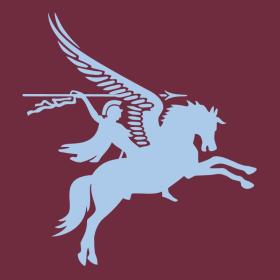
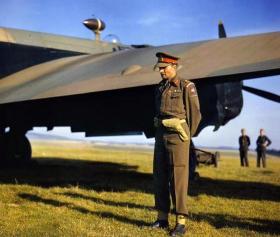

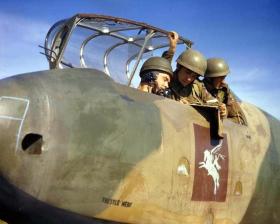
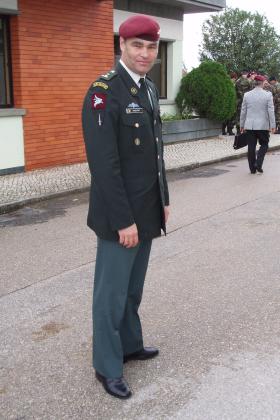

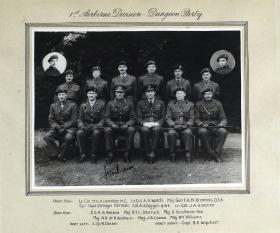
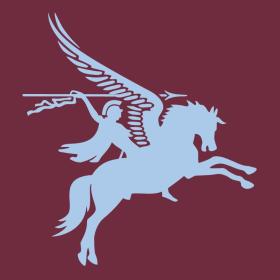
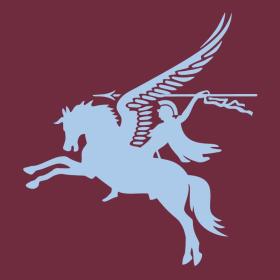
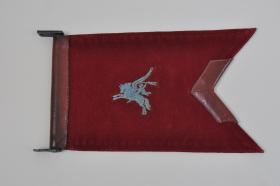

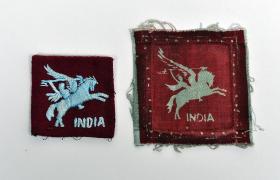
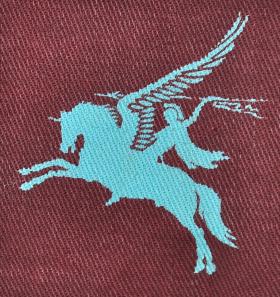
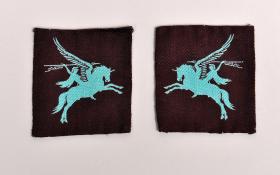
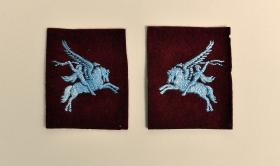
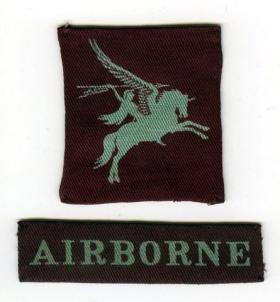
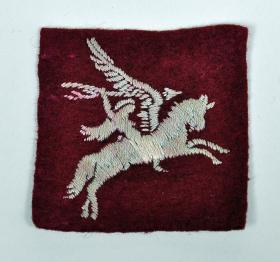
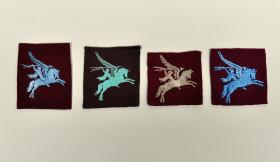
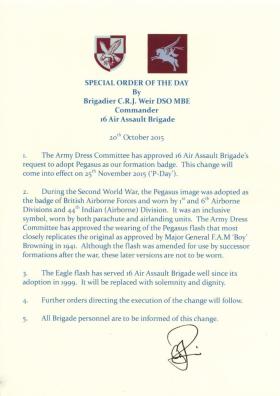
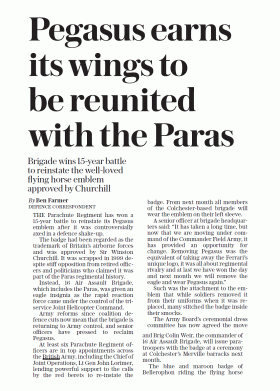
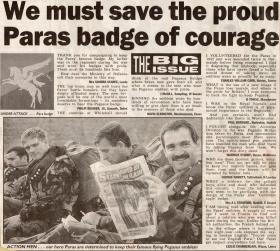
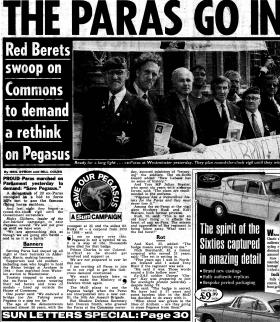
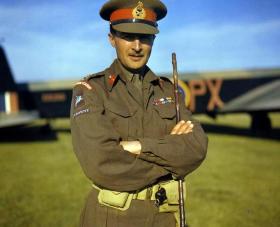
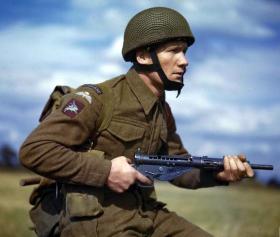



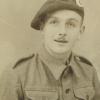
Latest Comments
There are currently no comments for this content.
Add Comment
In order to add comments you must be registered with ParaData.
If you are currently a ParaData member please login.
If you are not currently a ParaData member but wish to get involved please register.